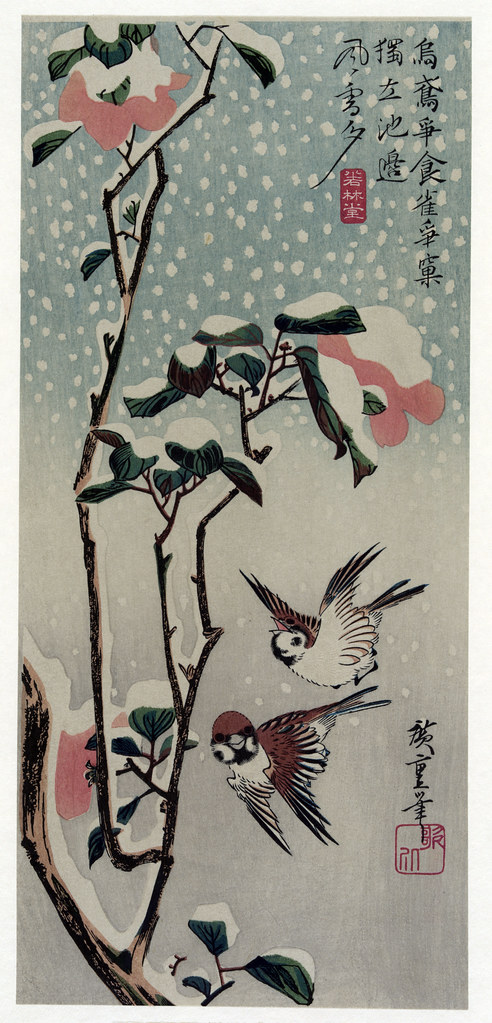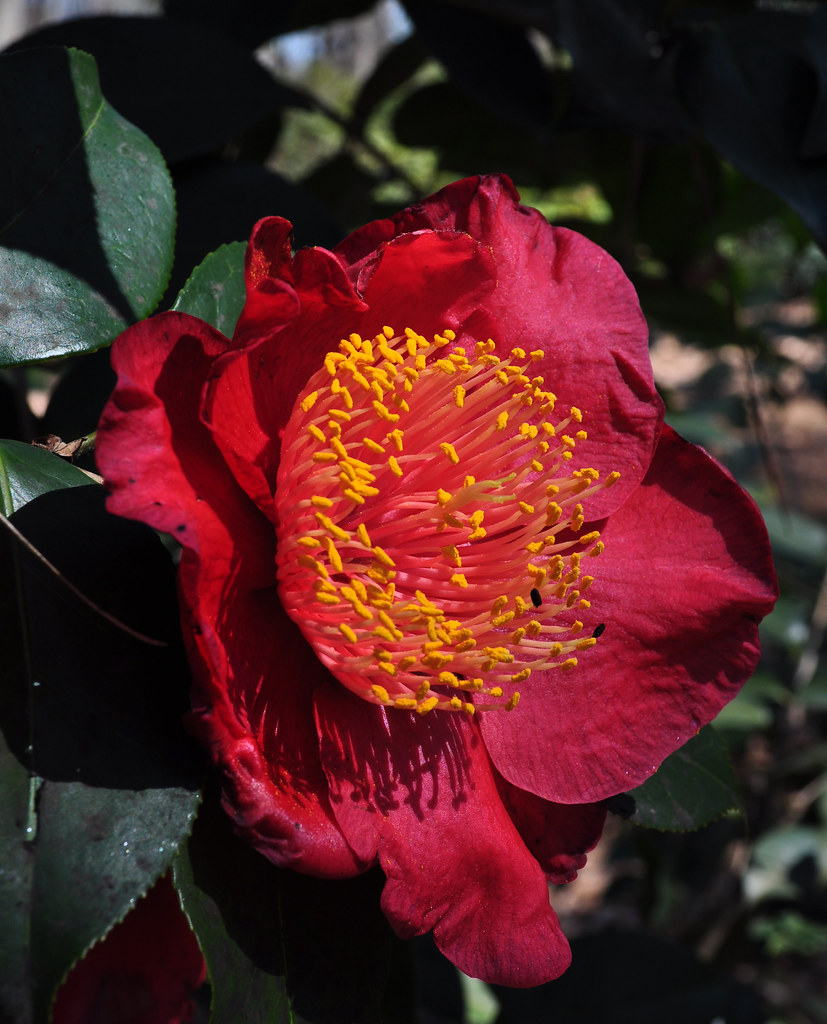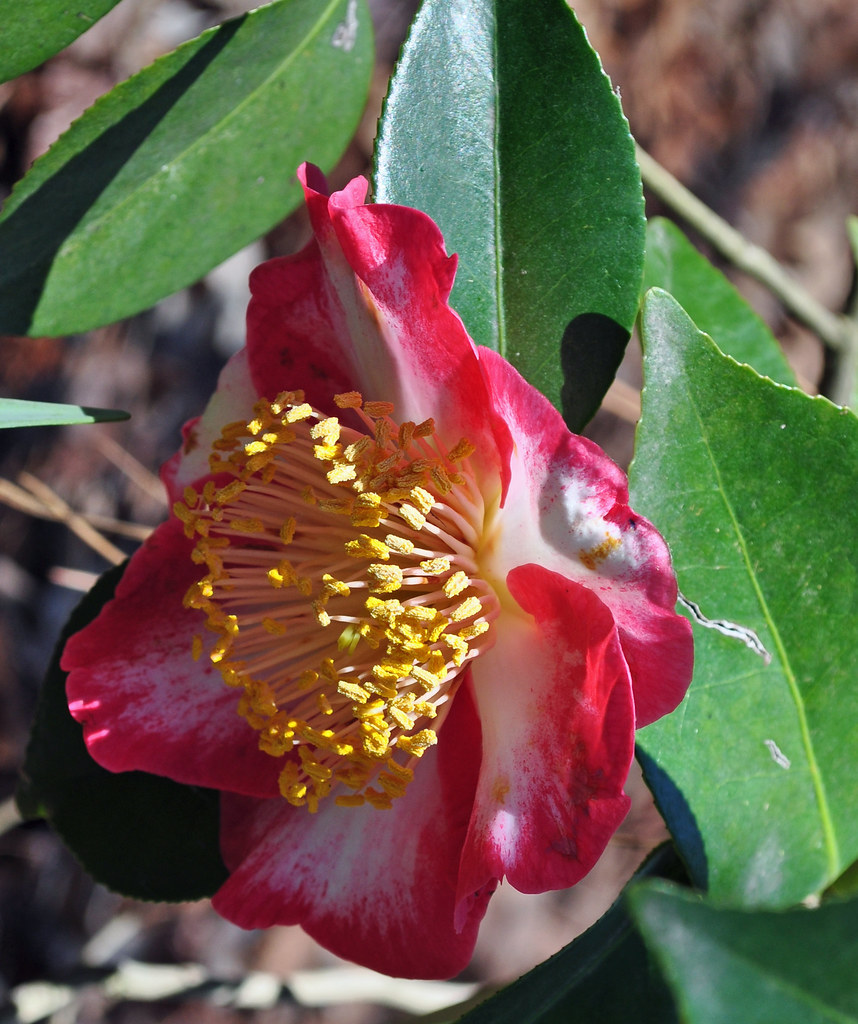Sparrows and Camellias, Hiroshige Utagawa
Earlier this winter, one of my favorite customers called me looking for a type of Camellia called Higo, which she said was the Samurai's Camellia. Even though I like to think I know more than a little about one of my favorite plants, I had not heard of these. Most of my ignorance about Samurais and feudal Japan came from reading James Clavell's Shogun and by watching Akira Kurosawa's Ran. Due to her enthusiasm for the plant I did a bit of reading on the topic and tried unsuccessfully to find a source I could access.
Camellia japonica 'Happy Higo'
Higo Camellias are a group of Camellia japonica cultivars that were indeed bred, selected and cherished by Samurais and their families. They take their name from the old Japanese province of Higo, which is now Kumamoto prefecture. There are several characteristics that distinguish these Camellias from others. The most important being lots of showy, exposed stamens (the more the better) that are arrayed in a sunburst pattern. The Japanese refer to this pattern as ume-jin, with ume from the word for Flowering Apricot (Prunus mume) and its similarly patterned stamens. Jin means soul or spirit, so with Camellias blooming in the cold of winter they came to symbolize the Samurai's bravery. Another important characteristic of Higo Camellias are flat, splayed back petals, few in number, often asymmetric, so as to call more attention to the perfect display of stamens. Another characteristic is the clean drop of spent blossoms. Higos were traditionally planted adjacent to the Samurai's burial place so that the fallen flowers could adorn the grave. As well as being a favored garden plant, they were also used extensively in bonsai.
Camellia japonica bonsai from Wikipedia Commons
After the Meiji Restoration in 1868 the Samurai's role in Japanese society was relegated to the myths of history, and the cultivation of Higos was no longer widespread. Individual varieties did manage to survive behind the gates of old family homes, at monasteries and in graveyards. Unfortunately much of Kumamoto and its Camellias were reduced to ashes in World War II. In the late 1950's the Higo Camellia Society was established in Japan, and they have now listed 120 Higo cultivars, including many rescues and a few more recently developed. I was able to find several on-line sources for Higos, but no wholesale growers. Perhaps that will change; while I was at the Norfolk Botanical Garden last week I saw local Camellia grower Bob Black of Bennetts Creek Nursery admiring the few Higos planted there.
Camellia japonica 'Okan'
If you are interested in learning more about Higo Camellias, the International Camellia Society has an informative page. I used their site and Sterling Macoboy's book The Illustrated Encyclopedia of Camellias to get most of my information. For those of you into overkill, I have also recently doubled the number of photos in my Flickr Camellia file.
March 26, 2010
Subscribe to:
Post Comments (Atom)


![479px-Japanese_Camellia_bonsai_55,_December_24,_2008[1]](http://farm3.static.flickr.com/2800/4465504447_122abd7a31_o.jpg)





Les,
ReplyDeleteInteresting read and what a show off camellia! Thanks for sharing it. Our La Peppermint has more blooms now with lots of red.
They can bonsai anything, can't they? I can only dream of growing Camellias here in Alaska.
ReplyDeleteChristine B.
Camellias are one of my latest things, and your photos don't do anything to help my willpower. Singles and stamens make me swoon ... and your photos are particularly swoon-worthy.
ReplyDeleteConnie
What a post to cheer up an overcast Saturday morning!
ReplyDeleteCamellia Bonsai, now there's a thought.
Very interesting. And so neat how the center is like a ray of sunshine. It must be neat working at a nursery and learning from your patrons new things.
ReplyDeleteLes, these Camellias are stunning! Thank you for giving us a little history lesson.
ReplyDeleteLes, that was so interesting. Thank you. I know very little about Camellias, but I think the restoration of the Higos is much like the Rose Rustlers of Texas saving old roses from abandoned cemeteries and such.~~Dee
ReplyDeleteThis was very interesting, Les.
ReplyDeleteRandy,
ReplyDeleteI really enjoyed your La Peppermint and will be on the look out for it.
Christine B.
Yes they can. My favorite form of bonsai are the mini groves of trees.
Hartwood,
Please don't blame me for any new obsession you might develop.
Jo,
I wish you clearing skies and quiet streets.
Tina,
Many of my customers mention new plants, and if I like what I read about them, they have lead to me getting them in to sell.
Di,
I hope I wasn't too teachy.
Dee,
From what I gathered, it is similar to rose rustling. I was going to mention that, but couldn't find the space to squeeze it in.
Helen,
You are quite welcome.
Les
Very interesting read. I enjoy the photos too.
ReplyDeleteVery interesting post Les. I had not heard of this class of Camellia before. It's beautiful.
ReplyDeleteWildstorm,
ReplyDeleteI appreciate that you have stopped by.
Sweetbay,
Now I have to get one or several for my own garden.
Les
Very interesting. I appreciate blogs that educate and inform. I wonder how your client came to know about them.
ReplyDeleteVery interesting, I had not heard of these camellias either. The bonsai is spectacular.
ReplyDeleteles, i posted a picture of camellia tama-no-ura on my blog, apparently just after you posted this. (i swear i didn't see it first, even though i'm a regular reader of your blog!) tama-no-ura must be a higo too? at any rate it's a japanese single with showy stamens. the white border gives it an unreal quality. very unusual. love all the info here.
ReplyDeleteI imagine the NBG was beautiful with its Camellia collection. I have seen so many Camellias with a big flush of blooms this year.
ReplyDeleteThe Higo samari tale is new to me. Wonderful to learn about it.
Swimray,
ReplyDeleteI am not sure how she heard about them, but was glad she shared.
Phillip,
Yes the bonsai is spectacular, but I would have thought a more subtle color would have been favored.
Daricia,
Thanks for commenting. Now that you have done it once, feel free to speak again. I posted to your blog about what I found out about your Camellia.
Janet,
It looks as if you and your husband have been very busy lately. Don't forget to take a breather every now and then. And yes, NBG was stunning, especially in the Camellia garden.
Les
That bonsai'ed camellia is just exquisite! Wow. I'm gonna have to think about that. A friend of mine here has several Higos that are quite interesting.
ReplyDeleteGreat post - I learned alot.
Ohhh, I so miss the Camilias of Scotland County NC. The town of Laurinburg was beautiful with them in the spring as is any old southern town.Thank you
ReplyDeletehttp://beyondmygarden.blogspot.com/
WOW! Glorious!!!!
ReplyDeletePam,
ReplyDeleteIs this your Camellia growing friend on Johns Island who has the Higos?
Beyond,
That is a lovely area on NC. Thanks for stopping by.
Abbey,
I appreciate you visit and your comments.
Les
Very interesting read. Thanks for doing the research on this. Lovely illustrations as well.
ReplyDeleteI like camellias and bonsai trees, well and now I find them combined! Great combination, a real joy to have one! Great post!
ReplyDelete